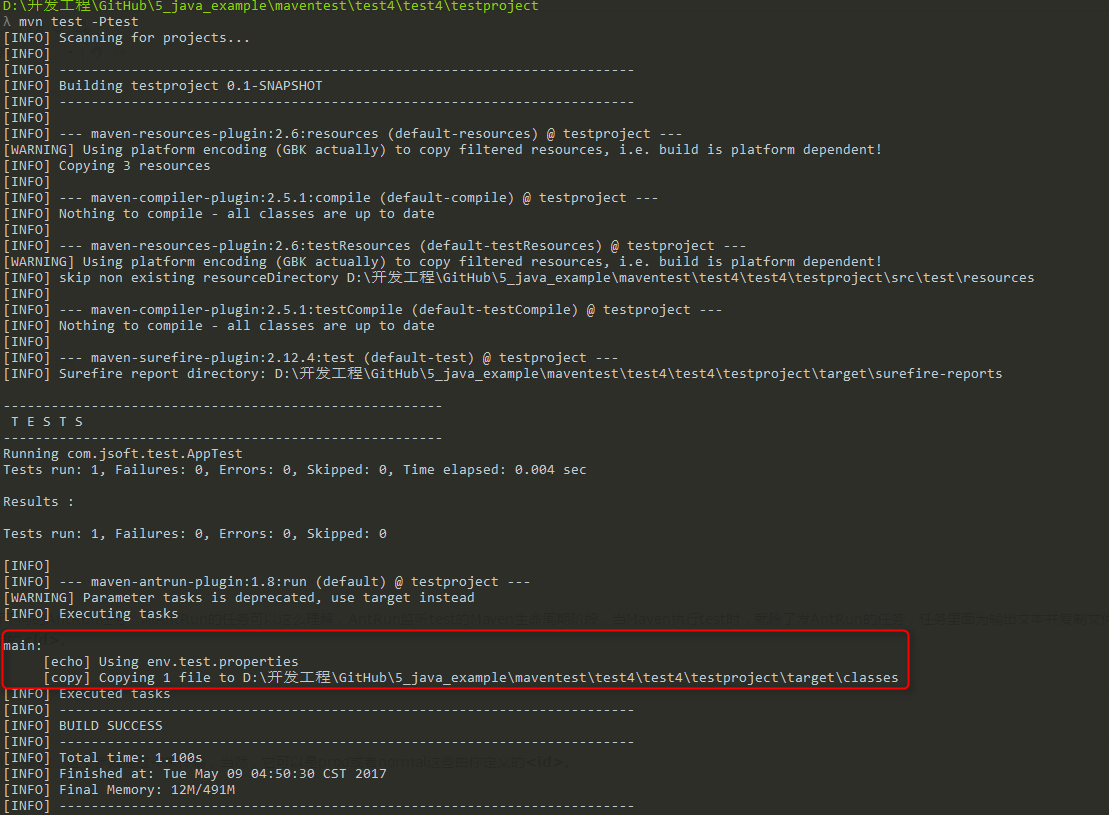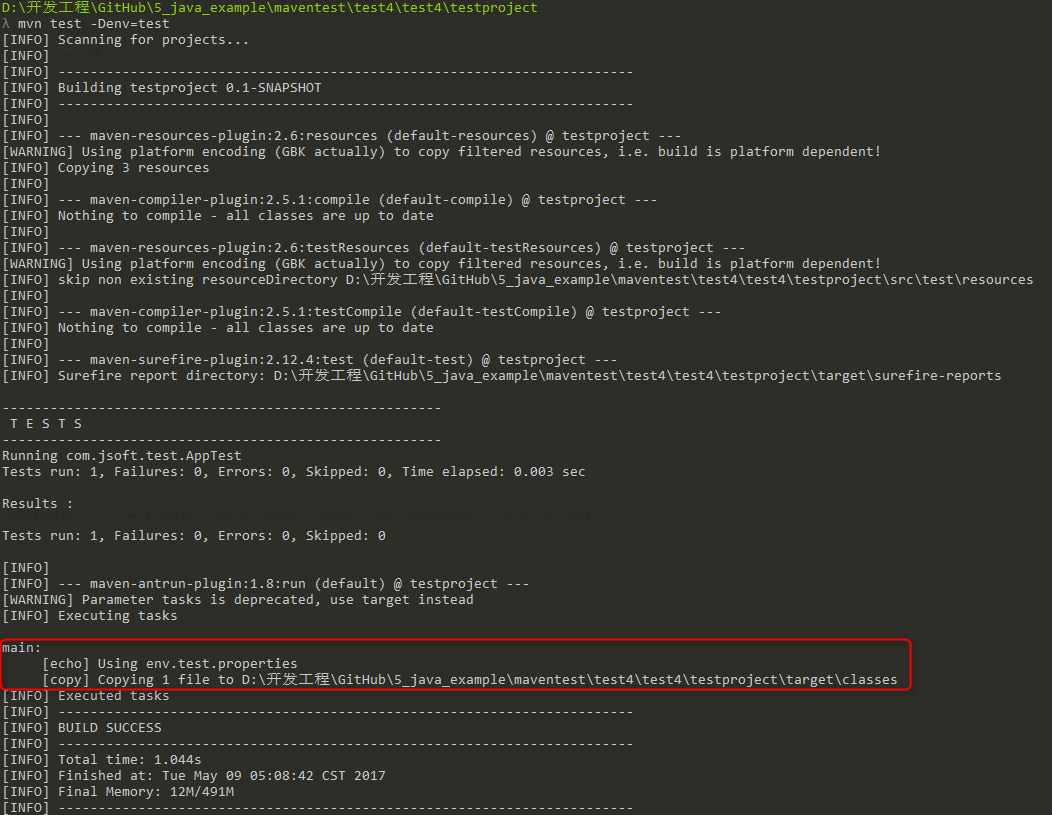Maven的构建配置文件(Build Profiles)
在命令行使用构建配置文件时,是-P,比如:mvn -Pinput注意:这里的构建配置文件并不是一个真正的文件,而是通过指定参数来做特定的事。
以下内容引用自https://ayayui.gitbooks.io/tutorialspoint-maven/content/book/maven_build_profiles.html:
当时此教程的例子是在2.0版本,而新的3.0版本只是增加了一点,具体可以参考官网http://maven.apache.org/guides/introduction/introduction-to-profiles.html
什么是构建配置文件?
构建配置文件(A Build profile) 是一系列的配置项的值,可以用来设置或者覆盖Maven构建默认值。使用构建配置文件,你可以为不同的环境,比如说生产环境(Producation)和开发(Development)环境,定制构建方式。
配置文件在pom.xml文件中使用activeProfiles或者profiles元素指定,并且可以通过各种方式触发。配置文件在构建时修改POM,并且用来给参数设定不同的目标环境(比如说,开发(Development)、测试(Testing)和生产环境(Producation)中数据库服务器的地址)。
构建配置文件的类型
构建配置文件大体上有三种类型
| 类型 | 在哪定义 |
|---|---|
| 项目级(Per Project) | 定义在项目的POM文件pom.xml中 |
| 用户级 (Per User) | 定义在Maven的设置xml文件中 (%USER_HOME%/.m2/settings.xml) |
| 全局(Global) | 定义在Maven全局的设置xml文件中 (%M2_HOME%/conf/settings.xml) |
配置文件激活
Maven的构建配置文件可以通过多种方式激活。
- 使用命令控制台输入显式激活。
- 通过maven设置。
- 基于环境变量(用户或者系统变量)。
- 操作系统设置(比如说,Windows系列)。
- 文件的存在或者缺失。
官方配置文件激活示例
http://maven.apache.org/guides/introduction/introduction-to-profiles.html
http://maven.apache.org/ref/2.2.1/maven-profile/profiles.html
实践配置文件激活示例
新建的项目结构如下:
其中在src/main/resources文件夹下有三个用于测试文件:
| 文件名 | 描述 |
|---|---|
| env.properties | 如果未指定配置文件时默认使用的配置。 |
| env.test.properties | 当测试配置文件使用时的测试配置。 |
| env.prod.properties | 当生产配置文件使用时的生产配置。 |
注意:这三个配置文件并不是代表构建配置文件的功能,而是用于本次测试的目的;比如,我指定了构建配置文件为prod时,项目就使用envprod.properties文件。
注意:下面的例子仍然是使用AntRun插件,因为此插件能绑定Maven生命周期阶段,并通过Ant的标签不用编写一点代码即可输出信息、复制文件等,经此而已。其余的与本次构建配置文件无关。
1、显示配置文件激活
pom.xml配置如下:

<project xmlns="http://maven.apache.org/POM/4.0.0" xmlns:xsi="http://www.w3.org/2001/XMLSchema-instance"
xsi:schemaLocation="http://maven.apache.org/POM/4.0.0 http://maven.apache.org/maven-v4_0_0.xsd">
<modelVersion>4.0.0</modelVersion>
<groupId>com.jsoft.test</groupId>
<artifactId>testproject</artifactId>
<packaging>jar</packaging>
<version>0.1-SNAPSHOT</version>
<name>testproject</name>
<url>http://maven.apache.org</url>
<dependencies>
<dependency>
<groupId>junit</groupId>
<artifactId>junit</artifactId>
<version>3.8.1</version>
<scope>test</scope>
</dependency>
</dependencies>
<profiles>
<profile>
<id>test</id>
<build>
<plugins>
<plugin>
<groupId>org.apache.maven.plugins</groupId>
<artifactId>maven-antrun-plugin</artifactId>
<version>1.8</version>
<executions>
<execution>
<phase>test</phase>
<goals>
<goal>run</goal>
</goals>
<configuration>
<tasks>
<echo>Using env.test.properties</echo>
<copy file="src/main/resources/env.test.properties" tofile="${project.build.outputDirectory}/env.properties" overwrite="true"/>
</tasks>
</configuration>
</execution>
</executions>
</plugin>
</plugins>
</build>
</profile>
<profile>
<id>normal</id>
<build>
<plugins>
<plugin>
<groupId>org.apache.maven.plugins</groupId>
<artifactId>maven-antrun-plugin</artifactId>
<version>1.8</version>
<executions>
<execution>
<phase>test</phase>
<goals>
<goal>run</goal>
</goals>
<configuration>
<tasks>
<echo>Using env.properties</echo>
<copy file="src/main/resources/env.properties" tofile="${project.build.outputDirectory}/env.properties" overwrite="true"/>
</tasks>
</configuration>
</execution>
</executions>
</plugin>
</plugins>
</build>
</profile>
<profile>
<id>prod</id>
<build>
<plugins>
<plugin>
<groupId>org.apache.maven.plugins</groupId>
<artifactId>maven-antrun-plugin</artifactId>
<version>1.8</version>
<executions>
<execution>
<phase>test</phase>
<goals>
<goal>run</goal>
</goals>
<configuration>
<tasks>
<echo>Using env.prod.properties</echo>
<copy file="src/main/resources/env.prod.properties" tofile="${project.build.outputDirectory}/env.properties" overwrite="true"/>
</tasks>
</configuration>
</execution>
</executions>
</plugin>
</plugins>
</build>
</profile>
</profiles>
</project>
注意:构建配置文件采用的是<profiles>节点。
说明:上面新建了三个<profiles>,其中<id>区分了不同的<profiles>执行不同的AntRun任务;而AntRun的任务可以这么理解,AntRun监听test的Maven生命周期阶段,当Maven执行test时,就除了发AntRun的任务,任务里面为输出文本并复制文件到指定的位置;而至于要执行哪个AntRun任务,此时构建配置文件起到了传输指定的作用,比如,通过命令行参数输入指定的<id>。
执行命令:
mvn test -Ptest提示:第一个test为Maven生命周期阶段,第2个test为为构建配置文件指定的<id>参数,这个参数通过-P来传输,当然,它可以是prod或者normal这些由你定义的<id>。
运行的结果如下:
可以看出成功的触发了AntRun的任务。并且是对应构建配置文件下的<id>为test的任务。
再测试其余两个命令,结果如下:
2、通过Maven设置激活配置文件
打开%USER_HOME%/.m2目录下的settings.xml文件,其中%USER_HOME%代表用户主目录。如果setting.xml文件不存在就直接拷贝%M2_HOME%/conf/settings.xml到.m2目录,其中%M2_HOME%代表Maven的安装目录。对于为什么可以这样做,参考:http://www.cnblogs.com/EasonJim/p/6827058.html
配置setting.xml文件,增加<activeProfiles>属性:

<settings xmlns="http://maven.apache.org/POM/4.0.0"
xmlns:xsi="http://www.w3.org/2001/XMLSchema-instance"
xsi:schemaLocation="http://maven.apache.org/POM/4.0.0
http://maven.apache.org/xsd/settings-1.0.0.xsd">
...
<activeProfiles>
<activeProfile>test</activeProfile>
</activeProfiles>
</settings>
执行命令:
mvn test提示:此时不需要使用-Ptest来输入参数了,上面的setting.xml文件的<activeprofile>已经指定了test参数,代替了。
提示2:同样可以使用在%M2_HOME%/conf/settings.xml的文件进行配置,效果一致。
执行结果:
3、通过环境变量激活配置文件
先把上一步测试的setting.xml值全部去掉。
然后在pom.xml里面的<id>为test的<profile>节点,加入<activation>节点:

<project xmlns="http://maven.apache.org/POM/4.0.0" xmlns:xsi="http://www.w3.org/2001/XMLSchema-instance"
xsi:schemaLocation="http://maven.apache.org/POM/4.0.0 http://maven.apache.org/maven-v4_0_0.xsd">
<modelVersion>4.0.0</modelVersion>
<groupId>com.jsoft.test</groupId>
<artifactId>testproject</artifactId>
<packaging>jar</packaging>
<version>0.1-SNAPSHOT</version>
<name>testproject</name>
<url>http://maven.apache.org</url>
<dependencies>
<dependency>
<groupId>junit</groupId>
<artifactId>junit</artifactId>
<version>3.8.1</version>
<scope>test</scope>
</dependency>
</dependencies>
<profiles>
<profile>
<id>test</id>
<activation>
<property>
<name>env</name>
<value>test</value>
</property>
</activation>
<build>
<plugins>
<plugin>
<groupId>org.apache.maven.plugins</groupId>
<artifactId>maven-antrun-plugin</artifactId>
<version>1.8</version>
<executions>
<execution>
<phase>test</phase>
<goals>
<goal>run</goal>
</goals>
<configuration>
<tasks>
<echo>Using env.test.properties</echo>
<copy file="src/main/resources/env.test.properties" tofile="${project.build.outputDirectory}/env.properties" overwrite="true"/>
</tasks>
</configuration>
</execution>
</executions>
</plugin>
</plugins>
</build>
</profile>
<profile>
<id>normal</id>
<build>
<plugins>
<plugin>
<groupId>org.apache.maven.plugins</groupId>
<artifactId>maven-antrun-plugin</artifactId>
<version>1.8</version>
<executions>
<execution>
<phase>test</phase>
<goals>
<goal>run</goal>
</goals>
<configuration>
<tasks>
<echo>Using env.properties</echo>
<copy file="src/main/resources/env.properties" tofile="${project.build.outputDirectory}/env.properties" overwrite="true"/>
</tasks>
</configuration>
</execution>
</executions>
</plugin>
</plugins>
</build>
</profile>
<profile>
<id>prod</id>
<build>
<plugins>
<plugin>
<groupId>org.apache.maven.plugins</groupId>
<artifactId>maven-antrun-plugin</artifactId>
<version>1.8</version>
<executions>
<execution>
<phase>test</phase>
<goals>
<goal>run</goal>
</goals>
<configuration>
<tasks>
<echo>Using env.prod.properties</echo>
<copy file="src/main/resources/env.prod.properties" tofile="${project.build.outputDirectory}/env.properties" overwrite="true"/>
</tasks>
</configuration>
</execution>
</executions>
</plugin>
</plugins>
</build>
</profile>
</profiles>
</project>
执行命令:
mvn test -Denv=test提示:上面使用-D传递环境变量,其中evn对应刚才设置的<name>值,test对应<value>。
提示2:在Windows 10上测试了系统的环境变量,但是不生效,所以,只能通过-D传递。
执行结果:
4、通过操作系统激活配置文件
5、通过文件的存在或者缺失激活配置文件
6、通过JDK的版本激活配置文件
...
更多激活配置,可以参考官方的例子:http://maven.apache.org/guides/introduction/introduction-to-profiles.html
测试工程:https://github.com/easonjim/5_java_example/tree/master/maventest/test4/test4/testproject
分类: 编程语言-[Java]
标签: java, maven, tutorialspoint-maven实践笔记
2
« 上一篇: Jenkins构建完成后通过SVN Publisher Plugin上传文件到指定的SVN(教程收集)
» 下一篇: Maven中的-D(Properties属性)和-P(Profiles配置文件)






























 9127
9127











 被折叠的 条评论
为什么被折叠?
被折叠的 条评论
为什么被折叠?








